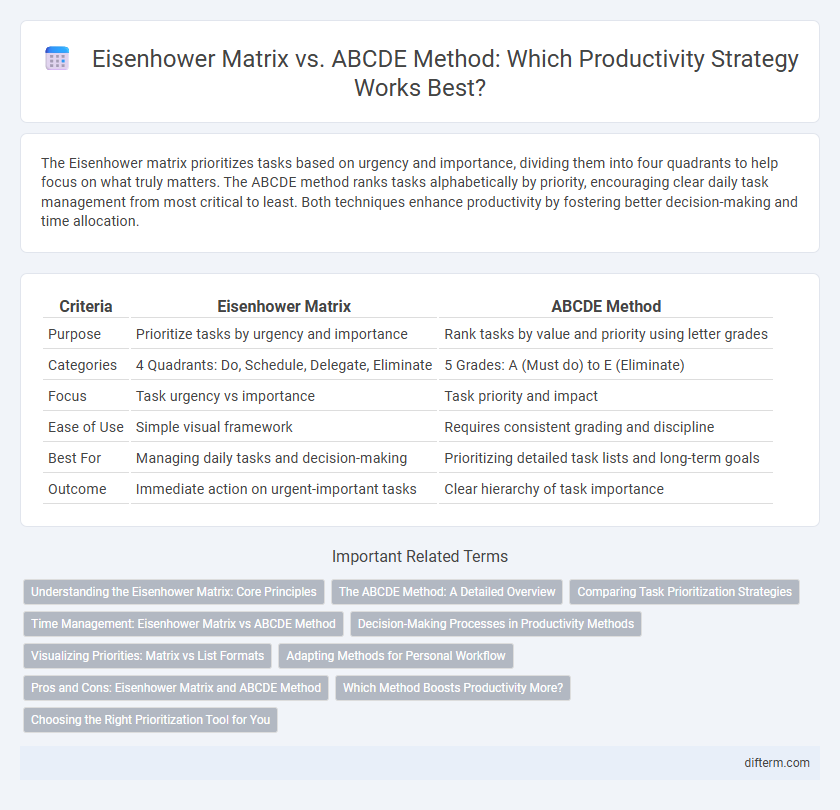The Eisenhower matrix prioritizes tasks based on urgency and importance, dividing them into four quadrants to help focus on what truly matters. The ABCDE method ranks tasks alphabetically by priority, encouraging clear daily task management from most critical to least. Both techniques enhance productivity by fostering better decision-making and time allocation.
Table of Comparison
| Criteria | Eisenhower Matrix | ABCDE Method |
|---|---|---|
| Purpose | Prioritize tasks by urgency and importance | Rank tasks by value and priority using letter grades |
| Categories | 4 Quadrants: Do, Schedule, Delegate, Eliminate | 5 Grades: A (Must do) to E (Eliminate) |
| Focus | Task urgency vs importance | Task priority and impact |
| Ease of Use | Simple visual framework | Requires consistent grading and discipline |
| Best For | Managing daily tasks and decision-making | Prioritizing detailed task lists and long-term goals |
| Outcome | Immediate action on urgent-important tasks | Clear hierarchy of task importance |
Understanding the Eisenhower Matrix: Core Principles
The Eisenhower Matrix categorizes tasks into four quadrants based on urgency and importance, enabling effective prioritization by focusing on what truly drives results. Its core principles emphasize managing urgent tasks immediately while scheduling important but non-urgent activities to reduce stress and increase productivity. This method contrasts with the ABCDE approach by providing a visual framework that clarifies task prioritization through time sensitivity and impact.
The ABCDE Method: A Detailed Overview
The ABCDE Method is a productivity technique that categorizes tasks by priority to enhance focus and efficiency, labeling items as A (most important) through E (least important). This method promotes disciplined task management by forcing users to assign a clear priority level, ensuring critical activities receive immediate attention. By systematically evaluating tasks, the ABCDE Method minimizes decision fatigue and accelerates goal achievement compared to the broader Eisenhower matrix.
Comparing Task Prioritization Strategies
The Eisenhower Matrix categorizes tasks by urgency and importance to help users prioritize daily activities effectively, while the ABCDE method assigns priority labels (A to E) to tasks based on their impact and consequences. Both strategies enhance productivity by providing clear frameworks for decision-making, but the Eisenhower Matrix emphasizes time sensitivity, whereas the ABCDE method focuses on task value and outcome. Choosing between these methods depends on whether prioritization is driven by immediate deadlines or long-term goal achievement.
Time Management: Eisenhower Matrix vs ABCDE Method
The Eisenhower Matrix prioritizes tasks by urgency and importance, categorizing activities into four quadrants to optimize time management and focus on critical responsibilities. The ABCDE method ranks tasks with letter designations from A (most important) to E (least important), enabling precise prioritization based on task impact and deadlines. Both techniques enhance productivity by structuring work dynamically, yet the Eisenhower Matrix better visualizes task urgency while the ABCDE method delivers granular control over priority levels.
Decision-Making Processes in Productivity Methods
Eisenhower Matrix categorizes tasks by urgency and importance, streamlining decisions between immediate action and delegation. ABCDE Method assigns priority levels to tasks, enhancing clarity in choosing high-impact activities first. Both frameworks optimize decision-making by structuring workload, reducing cognitive overload, and improving time management efficiency.
Visualizing Priorities: Matrix vs List Formats
The Eisenhower Matrix uses a quadrant format to visually separate tasks by urgency and importance, enabling quick prioritization through spatial organization. The ABCDE method employs a list format, ranking tasks alphabetically from highest (A) to lowest (E) priority, which simplifies sequential task management. Choosing between the matrix's categorical visualization and the list's linear ranking depends on individual preference for seeing priorities spatially or hierarchically.
Adapting Methods for Personal Workflow
The Eisenhower Matrix categorizes tasks by urgency and importance, allowing users to prioritize effectively in high-pressure environments. The ABCDE method assigns a letter grade to tasks based on their impact, offering a flexible ranking system that adapts to varied workloads. Combining elements from both methods enables tailored prioritization strategies that align with individual productivity rhythms and workflow demands.
Pros and Cons: Eisenhower Matrix and ABCDE Method
The Eisenhower Matrix excels at prioritizing tasks by urgency and importance, enhancing decision-making but may oversimplify complex workflows and lead to procrastination in non-urgent tasks. The ABCDE Method offers clear task ranking based on priority levels, improving focus and time management, yet it can be time-consuming to categorize all tasks and may cause rigidity in dynamic work environments. Choosing between these methods depends on the individual's workflow complexity and need for flexibility versus structure in productivity.
Which Method Boosts Productivity More?
The Eisenhower Matrix enhances productivity by categorizing tasks into urgent and important quadrants, helping users focus on what requires immediate attention and long-term impact. The ABCDE method prioritizes tasks through a letter grading system, driving efficiency by tackling high-value activities first and minimizing time spent on less critical tasks. Studies show that the ABCDE method often boosts productivity more effectively by simplifying decision-making and promoting consistent task completion.
Choosing the Right Prioritization Tool for You
Choosing the right prioritization tool depends on your work style and task complexity. The Eisenhower Matrix excels in categorizing tasks by urgency and importance, helping users quickly decide what to tackle first or delegate. The ABCDE Method offers a more detailed ranking system, assigning specific priority values to tasks, ideal for those who prefer detailed control over their task list.
Eisenhower matrix vs ABCDE method Infographic

 difterm.com
difterm.com